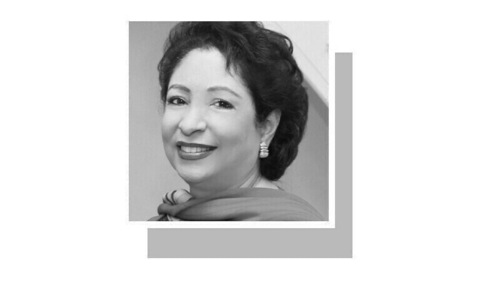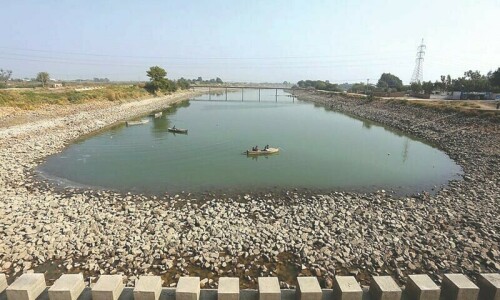ALTHOUGH Pakistan has experienced 12 episodes of balance-of-payments stress since 1988, requiring an IMF assistance programme on almost each occasion, the current crisis is by far the most severe. Facing a gross external financing requirement (ie the requirement of foreign exchange to meet the gap between receipts and payments) of over $27 billion in 2017-18, the largest in the country’s history, official reserves depleted rapidly and as a result, the rupee has depreciated 23 per cent since July 2018. This magnitude of weakening of the currency is the largest in the country’s history barring a 56pc devaluation effected in 1972.
Not surprisingly, the IMF programme agreed to by Pakistan and the Fund stipulates the largest fiscal adjustment undertaken by the country compared to all its previous programmes. By the end of the programme period in 2022, Pakistan is stipulated to achieve fiscal consolidation equivalent to 4.5pc of GDP. By comparison, the fiscal adjustment undertaken in the previous big crisis in 2008 amounted to 2.1pc of GDP.
Read: Pakistan reaches agreement with IMF, to receive $6 billion over 3 years
There are essentially four types of economic crises. A ‘classic’ currency crisis results from a sustained speculative attack on a usually fixed or inflexible (and overvalued) domestic currency. This is the type experienced by the East Asian economies in 1997. A balance-of-payment crisis can also occur when there is a ‘sudden stop’ to external inflows, or a sudden outflow of portfolio/hot money from the country’s debt and equity markets, precipitated usually by the start of an interest rate increase cycle by the US Federal Reserve. Pakistan has experienced a ‘sudden stop’-induced crisis at least once since the 1990s — in 1994.
The evolution and vector of economic crises are fairly ‘typical’.
(For this reason, among others, the governor State Bank’s recent ruminations about opening up the country’s onshore domestic debt market to foreign investment needs a dose of caution. It will increase the vulnerability of the external account — and very likely ‘lock’ the State Bank into higher domestic interest rates to ensure a high positive ‘carry’ for foreign investors. That in turn will worsen domestic investment conditions as well as impose a burden on public finances).
The third variety is one precipitated by a banking crisis, while the fourth emanates from an inability or unwillingness to service debt (hence, referred to as a debt crisis).
Although there can be, and usually are, overlaps between the four types of crises, with a crisis initially starting off as one type and then morphing into another, Pakistan’s external account crisis episodes have usually been characterised by large external trade imbalances, emanating from a small and narrow export base exacerbated by a prolonged overvaluation of the exchange rate. In more than one case, a sustained credit boom has preceded the episode of stress (2008), while difficulty in meeting external payment obligations has been a feature of the crises in 1990s — and is a big element in the external payment stress the country will witness in the next few years.
The unfortunate part is that most economic crises (barring sudden stops usually) are predictable well in advance. In our case, both the 2008 and the 2018 crisis were foretold. Readers of this column would recall my warnings from 2015 onwards of a ‘perfect storm’ on the horizon. In a growth episode, however, policymakers more often than not wear a ‘growth halo’ — and strong blinders. In our case, endorsements from international lenders, including the IMF, of flawed economic policies did not help either.
Understandably, market confidence has been impacted in the past one year as the economy has remained in turmoil, with output, investment and confidence-sensitive asset markets all performing poorly. However, most external account crises follow a fairly typical trajectory or vector — and Pakistan is no different.
The relatively recent experience of a host of countries (Greece, Argentina, Turkey, Ireland, Spain to name a few) suggests that as official foreign exchange reserves decline, and the currency markets experience a shortage of forex, confidence begins to evaporate. Initially this impacts not only the asset markets but in most cases the banking system as well (mercifully, Pakistan has escaped this — for now).
Declining confidence of economic agents, sharply curtailed access to credit, a steep contraction of purchasing power induced by the falling value of the currency and the associated inflation, are amplified by the defensive policy measures that authorities need to take (higher interest rates, taxation measures, expenditure reduction). The result is that the contagion effects are soon transmitted from the financial markets to the real sector. Large output losses are experienced, with resulting unemployment.
To put this in perspective, Greece’s economy shrank over 29pc between 2008 and 2016, while Ireland faced an economic contraction of almost 10pc in 2008-09 in the aftermath of the global financial crisis. Spain’s economy shrunk by over 9pc between 2009-13. Pakistan’s own experience of the 2008 crisis is of economic growth slowing down sharply to only 0.4pc in 2009, with large-scale manufacturing contracting 4.2pc. It is in this context that the recent upward revision in the State Bank’s expectation for growth in the economy this fiscal year appears optimistic.
One implication of this possible scenario is that the government needs to plan for a transition to growth. There will be disruption and upheaval in the economy as a result of the meaningful tax reform taking place, and a large expected rise in unemployment. Stabilisation is a necessary but not a sufficient condition for economic growth. Hence, the government will have to formulate a well-thought-out growth framework, with an industrial and an investment policy as its elements, and begin implementing these as stabilisation policy creates the space.
The other implication is that social safety nets may need to be rethought as well as expanded from the poorest to other vulnerable groups (the lower middle class and the young unemployed, for example). A subsequent article will examine whether the IMF programme delivers on the structural adjustment required for Pakistan to break its recursive history of economic boom and bust.
The writer is a former member of the prime minister’s economic advisory council, and heads a macroeconomic consultancy based in Islamabad.
Published in Dawn, July 19th, 2019















































